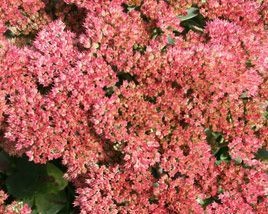Common orpine
(Hylotelephium telephium telephium)

Description
Hylotelephium telephium telephium, commonly known as the Common orpine or Sedum telephium, is a succulent perennial plant that belongs to the family Crassulaceae. It is native to Europe, where it grows in open grasslands, rocky hillsides, and in moist woodland areas. It is also widely cultivated as an ornamental plant in gardens. Description Hylotelephium telephium telephium is a herbaceous perennial plant that can grow up to 60cm in height. The stems are erect, fleshy, and branched, with a grayish-green color. The leaves are opposite, simple, and fleshy, with a waxy coating that helps to retain water. The leaves are elliptical in shape, up to 10cm long, and have toothed margins. The plant produces dense clusters of small, star-shaped flowers in late summer, which are usually pink, but can also be white, red, or purple. The flowers are hermaphroditic, meaning that they contain both male and female reproductive organs. Cultivation Hylotelephium telephium telephium is a hardy plant that is easy to grow and care for. It prefers a well-drained soil and a sunny or partially shaded location. The plant is tolerant of drought and can grow in poor soil conditions. It is best propagated by division, although it can also be grown from seeds. Propagation by division should be done in the spring or early autumn. The plant can be divided into smaller sections, and each section should have at least one healthy shoot and a portion of the root system. The plant can also be propagated by stem cuttings, which should be taken in the spring or summer and rooted in a moist soil mix. Uses Hylotelephium telephium telephium is primarily grown as an ornamental plant in gardens. It is prized for its colorful flowers, which attract pollinators such as bees and butterflies. The plant is also used in traditional medicine to treat various ailments. The leaves and roots of the plant have been used to treat respiratory problems, digestive disorders, and skin irritations. The plant is also believed to have antiseptic and anti-inflammatory properties. However, it is important to note that the plant can be toxic if ingested in large quantities and should not be used without consulting a qualified healthcare professional. In addition to its medicinal uses, Hylotelephium telephium telephium is also used in landscaping and erosion control. The plant's ability to tolerate poor soil conditions and drought make it an ideal choice for roadside plantings, embankments, and other areas where soil erosion is a problem. Conclusion Hylotelephium telephium telephium is a versatile and hardy plant that is valued for its ornamental, medicinal, and practical uses. Its attractive flowers and ability to tolerate drought and poor soil conditions make it a popular choice for gardens and landscaping. As with all plants, it is important to understand the plant's cultivation requirements and potential uses before planting or using it for medicinal purposes.
Taxonomic tree:







